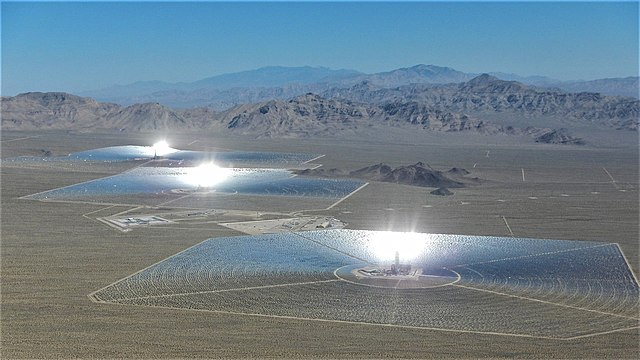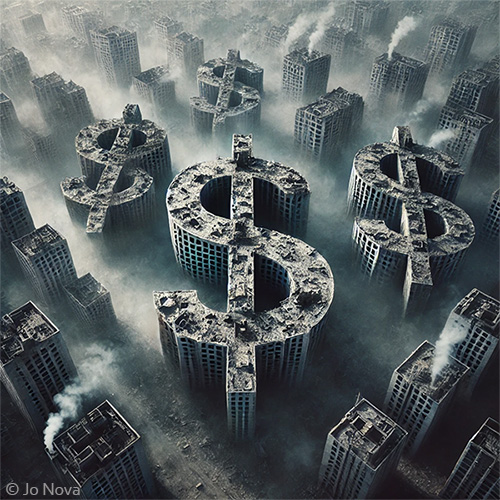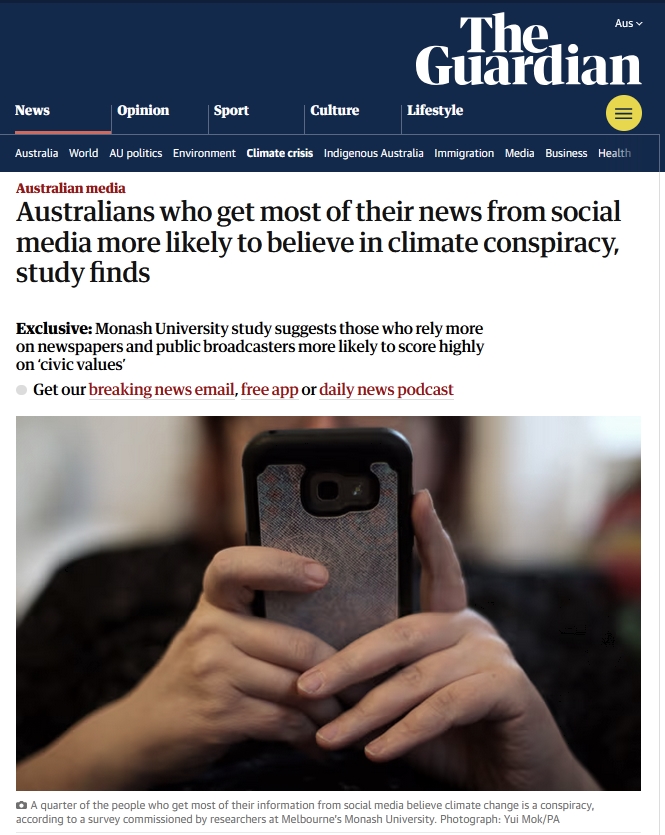|
|
|||||||||||||||||
 … By Jo Nova On closing it down Musk said: “USAID is a criminal organisation. Time for it to die.””On Friday last week, Elon Musk and DOGE wanted access to agency systems of the giant USAID. When senior officials refused, by Saturday they were put on leave. “Spent the weekend feeding USAID into the wood chipper,” Musk boasted on X.“It became apparent that it’s not an apple with a worm it in,” Musk said in a live session on X Spaces early Monday. “What we have is just a ball of worms. You’ve got to basically get rid of the whole thing. It’s beyond repair.” — AP News Elon Musk and DOGE closed the doors, and sent the head honcho’s packing. One officeworker said staff rushed to take down things like Pride Flags and incriminating books (whatever that means), and now they have lost access to their computers, and the site is down. As Donald Trump and Elon Musk cut back rogue government agencies, USAID looks more and more like a giant money laundering racket. It has (or had) 10,000 employees and a budget of $50 billion dollars. It’s presented as a humanitarian aid group, but the AID in US-AID means the US Agency for International Development which turns out to mean anything and everything. The humanitarian projects include giving $53 million dollars to the starving EcoHealth Alliance which used that to pay for bioweapon research in Wuhan, China, helping to create Covid-19. USAID also funded the production of heroin in Afghanistan. The WhiteHouse revealed that USAID also funded DEI projects in Serbia, and DEI musicals in Ireland. They spent US Taxpayer money on transgender operas in Colombia and a trans comic book in Peru. As Mike Benz describes it, USAID was the Ultimate Nerve Center Of A Rogue Foreign Policy Establishment
Mike Benz, former State Department Cyber expert, has studied USAID closely and says: “USAID grantee NGOs literally take their USAID money then turn around and lobby all key members of Congress to give more and more US taxpayer money to USAID each year in the budget. USAID buys an army of lobbyists with your tax dollars to give it more of your money.“ He also wonders why USAID gave $27 million to the US fiscal sponsor of the group controlling Soros-funded prosecutors and telling them which American citizens and politicians to prosecute? Indeed, somehow USAID is also one of the “BBC Media Actions” top ten donors? Go figure? It’s just the US of A helping out third world countries like the UK, right? As Mike Benz said: the “BBC was in direct cahoots with USAID leadership on Internet censorship efforts to crush BBC’s online populist news competitors since 2017. I went over 9 hours of receipts on this in a 3-part private livestream lecture for my X subscribers”. The BBC part of The Blob takes Blob money to lobby to cripple the media outside The Blob’s control. The words “Self Serving” come to mind. Ron Paul agrees — USAID is a key component of US Regime change, meddling in foreign affairs. The news from Ukraine is essentially being controlled by USAID. Ukrainian media is Blob media. How sweet — USAID provides bioweapons to poor nations that can’t afford their own
Mike Benz — “The Blob uses AID workers to get s*** done”Benz considers USAID as the core tool the Deep State use to make things happen. He argues that the State Department can’t get directly involved in other nations politics — not in underhanded ways, and nor can the CIA openly do that, but correctly funded aid-workers can. He doesn’t think the funding of DEI and Pride marches is necessarily just crazy lefty religious zeal, it’s a strategy he calls “tactical wokeness in service of statecraft.”. The idea, he argues, is that to topple governments — like say, Bangladesh or Cuba — a bit of tactical wokeness would inflame and divide populations who then rise up and protest and unsettle the elected governments that the CIA don’t like. The DEI Wokeness programs are designed to incite street riots and sometimes “color revolutions”. He gives one example where, the International Republican Institute (IRI)* funded dance festivals and woke identity events in Bangladesh, and minority rappers that culminated in throngs of street protests that forced the democratically elected leader to leave the country in a helicopter, as a Clinton Global Initiative fellow was installed as the new President, and they cancelled the elections. The push to censor:The US State department created the CIA to do the dirty jobs that it wanted to do. Then in the 1970s the CIA got caught, so they captured the USAID program, and according to Mike Benz, used the “aid” program to get inside the doors and mess with politics at arms length, in a dirty way. Now that they are being caught again, it’s no accident they’ve become the leading sponsor of censorship programs all over the world so that their dirty work isn’t discussed and unraveled in public. More on that soon… The Background on the Deep State: Dont miss the first post on how the US intelligence agencies started rigging elections in 1948, and Mike Benz’s “History of the Intelligence State” see it here. It is essential background to understanding how the Blob grew out of good intentions after WWII and metastasized into a global monster. It is how The Spy agency became the Lie Agency. __________ * is the Republican arm of the NED (National Endowment for Democracy.).
Finally, the rebellion begins in the business sectorAfter years of silence, the first large industry body has broken the Climate Stupid Spell and said the obvious. There is a “national energy emergency” pushing up the price of food, and the cause of high energy prices is Labor’s 82% renewables target. The Independent Food Distributors Australia (IDFA) which supplies food to 60,000 shops and markets in Australia has broken with other large industry bodies and said the government should drop the “ideological” renewables target and upgrade our coal power plants and install new gas plants. For years, only schoolgirls were allowed to dictate national energy policy, now adults in business can too! The food industry lives and breathes on fossil fuels for their fridges, freezers and trucks, and electricity costs have gone up 50% since Labor came into office. So two weeks after King Trump takes office, and with only weeks or months until our own election, finally they brave up enough to say the Renewables Emperor has no clothes. Give Richard Forbes (the CEO) a medal — he is blistering and blunt. He didn’t just ask the Labor Party to slow the rush, but to “drop it” because of the “damage being done”. He said the Labor Party must take responsibility for the cost of living crisis. Calling climate change targets ideological is a blasphemy like burning the climate bible. There’s no pandering in that word. Forbes could have said the Labor Party target is too ambitious, or unrealistic. But instead he used the word ideological — thus declaring the net zero push it’s irrational, and driven by religious zeal. The managing director of Godden Food Group went even further, calling on the Opposition leader in Australia to “join Donald Trump in leaving the Paris Agreement”. Some of his four year electricity contracts have been renewed in NSW at 238% higher cost. This is dynamite in an election year: Food firms revolt over Labor’s energy plan
Employers supplying food to major supermarkets and thousands of cafes, restaurants and pubs have launched a revolt against Anthony Albanese’s energy policies, urging Labor to dump its 82 per cent renewables target and focus on ramping up more gas and coal production to bring electricity prices down in the short term. Business owners in the sector have told The Australian they want the government to drop its “ideological” approach to energy and instead support upgrades of existing coal-fired power stations while bringing on new gas peaking plants. Employers also want the government to fast track the approvals of new coal mines and gas fields to lower the price of baseload power, disagreeing with Energy Minister Chris Bowen’s claim that new renewables projects are the answer to lower prices. IFDA chief executive Richard Forbes said there was a “national energy emergency”, arguing the government’s policies were driving up the price of food for consumers. “Food businesses are sick and tired of hearing the government saying they are doing something about the cost of living, when their costs, particularly energy costs, are soaring. “The government must take responsibility for a portion of the cost-of-living crisis, which is the cost of doing business, which is energy. In reply, the Minister Chris “Blackout” Bowen sticks with the ideological fairy tale, blaming failing coal plants for high prices:Rejecting the push from food distributors, a spokesman for Mr Bowen said experts had found that “unreliable coal generators are driving price spikes”. “Extending them further would be a recipe for disaster,” the spokesman said. He speaks as though aiming for “no coal plants”will fix a problem caused by a lack of coal plants. The argument is so self-evidently stupid, as long as it is played out in public to its obvious end, the Labor Party will be fried on screen. This is the dead-end electricity hole the innumerate dullard left have galloped into. They think that magically generating a $650 electricity rebate is the same thing as generating electricity. One method makes us stronger and richer while the other just steals tax or purchasing power from average Australians to hide the real cost. The Labor tools of oligarchs, renewable investors and foreign powers couldn’t see past the namecalling and word-games, and fell for every kindergarten trick in the Book of Woke. If the conservatives (which fell for most of the same tricks) can get their acts together and copy Trump, there could be a bloodbath.
 Post-modern temples to the Sun God By Jo Nova It was supposed to last 50 years...The PR writers want us to believe the legendary Ivanpah has been beaten out by better cheap solar, and that this is somehow a “success”. But the truth is, it’s been killed by the same subsidies and crooked market that birthed it. The Big Government Blob distorted the free market, and created a boom in solar power. But the business case was not that good, there was no miracle in the storage of electricity, nobody wanted fried birds, and the subsidies kept forcing more solar power generation in at the same useless time of day. Since there were too many generators at lunchtime and not enough customers, the last surviving part of the free market has solved the imbalance. Just another artificial boom and bustIn 2014, the project cost $2.2 billion dollars. Ivanpah has 173.000 heliostats, and theoretically could make 390 megawatts in a perfect moment. But no one in their right mind would have spent so much to get so little, so the government spent $1.6 billion taxpayer dollars as a “loan guarantee”. I wonder how that is working out for the taxpayers, especially now that the capital depreciation has shifted from 50 years to 11. 11 years after a celebrated opening, massive solar plant faces a bleak future in the Mojave DesertLOS ANGELES (AP) — What was once the world’s largest solar power plant of its type appears headed for closure just 11 years after opening, under pressure from cheaper green energy sources. Meanwhile, environmentalists continue to blame the Mojave Desert plant for killing thousands of birds and tortoises. The Ivanpah solar power plant formally opened in 2014 on roughly 5 square miles of federal land near the California-Nevada border. Though it was hailed at the time as a breakthrough moment for clean energy, its power has been struggling to compete with cheaper solar technologies. So it was struggling to compete with cheaper solar technologies, and yet, in a market where customers keep paying more and more all the time, it still couldn’t make money? Even the Sierra Club didn’t like it: “The Ivanpah plant was a financial boondoggle and environmental disaster,” Julia Dowell of the Sierra Club said in an email. “Along with killing thousands of birds and tortoises, the project’s construction destroyed irreplaceable pristine desert habitat along with numerous rare plant species,” Dowell said. “While the Sierra Club strongly supports innovative clean energy solutions and recognizes the urgent need to transition away from fossil fuels, Ivanpah demonstrated that not all renewable technologies are created equal.” Apparently the plant would sometimes blind drivers too. It certainly blinded investors. The company did not reply to AP questions about what would happen to the giant industrial wreckage. h/t To Willie Soon! Ivanpah Photo by Cliff Ho. – U.S. Department of Energy from United States
By Jo Nova Such is the network of the Blob, even here in the last outpost of Western Civilization, in the city furthest on Earth from Washington DC, The ABC Blob TV news made sure we knew that Robert F Kennedy Jnr was a “headache” for Donald Trump, and a guy who believed wild conspiracy theories and hung out with quacks. Yesterday they prepared us for his confirmation hearings by interviewing his cousin. She called him a predator. What they would not show Australians is a few minutes of Kennedy speaking for himself, discussing medical studies in intricate detail. Apparently Australians don’t need to know that not even one US childhood vaccine was pretested in a long term placebo controlled trial. They just need the family gossip about the man who might be a health minister soon in a foreign country. This was our national prime time news. Our ABC Blob TV, paid by us, replayed the Congressional critics, hid Kennedy’s replies, and also hid that Big Pharma money was greasing the palms of most of the critics. RFK Jnr is roughly the Antichrist to Big Pharma, so looking for Big Pharma influence among his critics is the obvious thing to do. But our award winning celebrity journalists missed it. Citizen journalists on X, like A Midwestern Doctor, figured it out instead:
The figures they quote come from Open Secrets, so the paid journalists just had to google. If they had, they’d know that the corruption goes right to the top. You’ll never guess which politicians Big Harma like the mostMoney from Pharmaceuticals / Health Products to US Senators, 1990-2024
The Big Government Blob is so nebulous but extensive, the ABC / BBC /NPR and CBC journalists wouldn’t even feel like they were a part of it. But every one of them is paid by the Big Government Blob, trained in Blob Universities that feed off Big Government funds. They were probably taught to read in Blob schools, with a Blob curriculum. They have Blob Friends, they marry Blob people, and they learn to scorn the riff raff outside The Blob. They know smug insults about the Rednecks will impress their friends. They know that being anti-vax is social death. Pfizer and the CIA didn’t have to phone up the ABC to ask them to paint RFK Jr as a freak, or to cover for the racketeering politicians. ABC journalists do it voluntarily. All parts of the Blob are cheerleaders for all the other parts. Their salaries depend upon it. So does their social status. REFERENCES ABC WA News Jan 30th 2025: 17 minutes
 Net Zero Dreams in ruins. By Jo Nova We’ve reached the flipping point downunderThe money is leaving the room. Australian pension funds manage assets of around $4.1 trillion, and until last week, many of them had Net Zero Targets. Certainly, there were none that tried to appeal to climate skeptics even though 70% of Australians didn’t want to even spend $1 a week on “Net Zero” plans. This week, many of them are backing away slowly, speaking about a corporate and political backlash, like it’s a force of nature. They won’t say the subsidies have dried up, they made the wrong bet, wasted billions of your dollars and hope they don’t get sued for a lack of fiduciary duty. They won’t say that pension funds are supposed to make money for their clients, not change rainfall patterns. Last year, they were saying “Climate change poses a grave risk to the health, wellbeing and finances of all Australians, including retirees”. Three years ago the The Association of Superannuation Funds of Australia (ASFA) was campaigning for national net-zero policies saying “, the superannuation industry stands to lose billions of dollars in investment returns on behalf of their members,”. Pension funds were even supposed to hassle green businesses to “support them” on their journey of mitigation — like climate cops paid to hassle companies to follow laws laid out by global bankers, instead of elected governments. Look how soft the headline is: Super funds preparing to walk back their commitment to climate targetsBy Cliona O’Dowd, The Australian Australia’s most powerful super funds appear to be laying the groundwork to potentially walk back their climate targets amid a growing political and corporate backlash against ESG. As funds come to terms with the shift in sentiment and a four-year term of the Trump presidency, the industry is now voicing its concerns on meeting climate pledges made at a time when pushback against an environmental, social and governance focus was on the fringes. Speaking to The Australian on Tuesday, Association of Superannuation Funds of Australia chief executive Mary Delahunty said funds’ climate goals could be hampered by the anti-ESG movement, with engagement potentially less effective as corporates backtrack on the green agenda. Get out of HESTA: HESTA CEO Debby Blakey appeared to be the outlier, saying the healthcare industry super fund was committed to its climate targets. These include a 50 per cent reduction in portfolio emissions by 2030 and for the fund’s portfolio to be net zero by 2050. US elections make more difference to Australian policy than Australian elections do. By Jo Nova The Blob are afraid they will lose even more followers to social media…Academics and the old dying media have produced a study that “shows” people who believe social media posts are bad people. The message here for believers is that only horrible people get their news from sites like X or TikTok. Those selfish people score badly on civic values. The trick in this “peer reviewed” propaganda is how they define civic values. You might think it means checking on elderly neighbors, donating to charity, or volunteering at the Scouts, but actually “Civic values were defined as an individual’s belief in democratic institutions “. So if you question parliament or universities you are not a good citizen. The institutions are sacred! This transparent paper is just a get-out-of-jail free card for sloppy, self serving academics. Mike Benz warned us that the Blob redefined “democracy” as “democratic institutions” in 2016, which meant people could be tarred with the “anti-democratic” brush if they criticized the “essential institutions” of democracy, like elections, insurrections, vaccines, or senile Presidents. The left destroy the meaning of words to deceive their flock. The right let them get away with it. Australians who get most of their news from social media more likely to believe in climate conspiracy, study findsAmanda Meade, The Guardian Those who believe global heating is a conspiracy get most of their information about news and current events from commercial and social media, according to a study by researchers at Monash University. The study, led by Prof Mark Andrejevic and Assoc Prof Zala Volcic, found that those who relied on social media as the main source of news scored lower on a measure of “civic values” than people who relied on newspapers and non-commercial media. Civic values were defined as an individual’s belief in democratic institutions and practices, as well as their openness to considering perspectives that challenged their own. Of course, having redefined “civic values” they can also define “conspiracies” any way they want. Even if a Nobel Prize winner is not convinced about a wild hypothesis invented by B-Grade modelers, just call it a conspiracy… For the climate change question, researchers asked whether “fluctuations in the climate are the result of natural cycles that take place regardless of human activity”. Of those who got most of their news from commercial TV and radio, 37% agreed with the statement. Of those who got most of their information from social media, 25% believed climate change was a conspiracy. To rephrase, nearly 40% of the people said climate fluctuation is natural, which presumably the team at Monash would call a “conspiracy”. The Sun colludes with the moon-wolf or something. But the social purity of the ABC radio audience is 98%. These publicly funded “journalists” are practically offering hypnosis. Obviously they never present both sides of the story. If they did that, the ABC audience would form more a bell curve of opinions, rather than a religious believer 98:2 split. Conversely, those who disbelieved in conspiracies about climate change were more likely to get their information from public broadcasters ABC and SBS. Only 2% of those whose main source of information was public radio and 6% of those whose main source was public television believed the climate crisis was a conspiracy. So 98% of public radio listeners all think the same thing on a complex topic, and this is supposed to be a sign of a healthy democracy? But the good news is that 60% of Australians mainly get their news from social media sources. No wonder the Blob is aquiver. Only 34% got their news from Channel Seven, Nine and Ten, and just 6% got it from ABC or SBS public broadcasters.
REFERENCE
By Jo Nova The dam has brokenTrump has only been President for a week, and already policies on the far side of the world are shifting. Just like that, the European Union has realized they might have too many green regulations. It’s only a “leaked draft” of a five year economic plan — but the favored hyperbolic term du jour “unprecedented” now applies to deregulation, not climate change: ““This Commission will deliver an unprecedented simplification effort…”. And apparently, next months unprecedented effort is just the first round of simplifications. The draft document says they need to adapt to “new realities” — like possibly that the US economy is about to unshackle itself from the Net Zero ball-and-chain-fantasy and eclipse the EU. EU’s new economic vision is speaking to Green Deal criticsA draft document shows Brussels putting deregulation before decarbonization. Zia Weise, Politico BRUSSELS — The European Union’s new economic “compass” has a north star the burgeoning movement to revoke stringent green rules will love. A leaked draft of the European Commission’s competitiveness compass — an economic doctrine to guide the EU executive’s work for the coming five years — points toward widespread deregulation targeting the European Green Deal in particular. Naturally, the EU will “stay the course” on its climate targets (that’s what they all say, as they back away). But the Polish Prime Minister Donald Tusk demanded a “full and critical” review of the EU’s Green Deal last week and laid the cards out about as bluntly as anyone could: “If we go bankrupt no-one will care about the world’s environment any more,” Tusk said, calling for an honest, full and “very critical review of all regulations, including those arising from the Green Deal”. Tusk wants any review to identify and change EU laws that may lead to higher energy prices. “There is, for example, the issue of ETS 2 in front of us,” he said, singling out the separate trading system covering emissions from road transport and heating fuels, which is scheduled to launch in 2027. — EU must be honest about Green Deal — The Argus Unthinkably, Tusk even appeared to suggest that the Green Deal had caused high energy prices: He called for a “review of all legal acts including those under the Green Deal” and for “courage to change those rules that might result in prohibitively high energy prices,” attacking, in particular, a carbon fee on fossil fuels used to heat homes and power cars coming into force in 2027. — Politico France is also asking the EU to delay the corporate sustainability rules. The French “far-right” (sensible) Jordan Bardella wants to “tear down the European Green Deal”. He is urging conservative parties to work together to kill off the Green Deal altogether. In the end Trump may kill Green movements all over the world, not by invading, but through free speech, capitalism and competition. That’s why they hate him so much. The whole levitating fantasy of global weather control could only be maintained if every other western nation kept up the Cosplay game. Hat tip to Tallbloke.
I’ll be back soon…
Happy Australia Day |
|||||||||||||||||
|
Copyright © 2025 JoNova - All Rights Reserved |
|||||||||||||||||

















Recent Comments